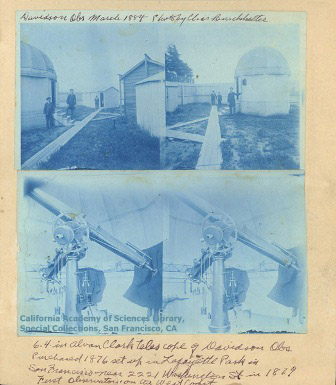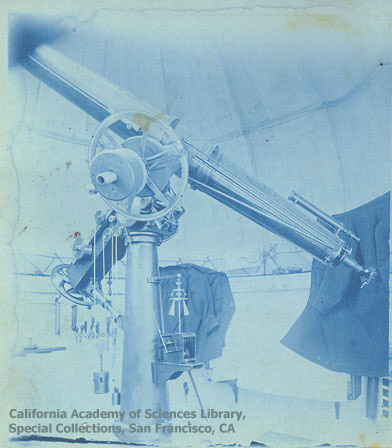Last week, I did a small tour for some staff members who were interested in seeing what types of photographic materials we have in our collections. I mostly chose items from the George Davidson collection because it contains several types of photographic processes.
George Davidson was an astronomer, geodesist, and coastal surveyor. In 1868, Davidson was made chief of the U.S. Coast Survey on the Pacific Coast and held that position until June 1895, during which time he oversaw the work of all western survey teams. Davidson was President of the California Academy of Sciences from 1872-1886. He was instrumental in popularizing astronomy on the West Coast and made his private observatory that is featured below, in Lafayette Park, San Francisco available to the scientific community and the public.
[caption id="" align="aligncenter" width="336" caption="Cyanotypes from the Davidson Observatory"]
 [/caption]
[/caption]
For the tour, I pulled various types of photographs including stereopticons, glass lantern slides, glass plate negatives, and cyanotypes.
The cyanotype was invented in 1842 by John Herschel but was most widely used from the 1880s to the 1920s. In this contact printing process, paper is coated with a solution of light-sensitive iron salts. A negative or object is placed on the paper and when exposed to ultraviolet light the chemicals react to form ferric ferrocyanide and ferrous ferricyanide, known as Prussian blue and Turnbull’s blue when used as pigments, and a blue image appears. Once the desired image is acquired the solution is washed away. This is the same process used in making blueprints. Because cyanotypes continue to be light-sensitive after their creation, they should be stored in the dark to prevent fading and damage.

6.4 inch Alvin Clark telescope in the Davidson Observatory
While this process was never very popular for photography, we have several cyanotypes in our manuscript collections including the Alice Eastwood and Barton Warren Evermann Collections.
- Danielle
Archives and Digital Collections Librarian